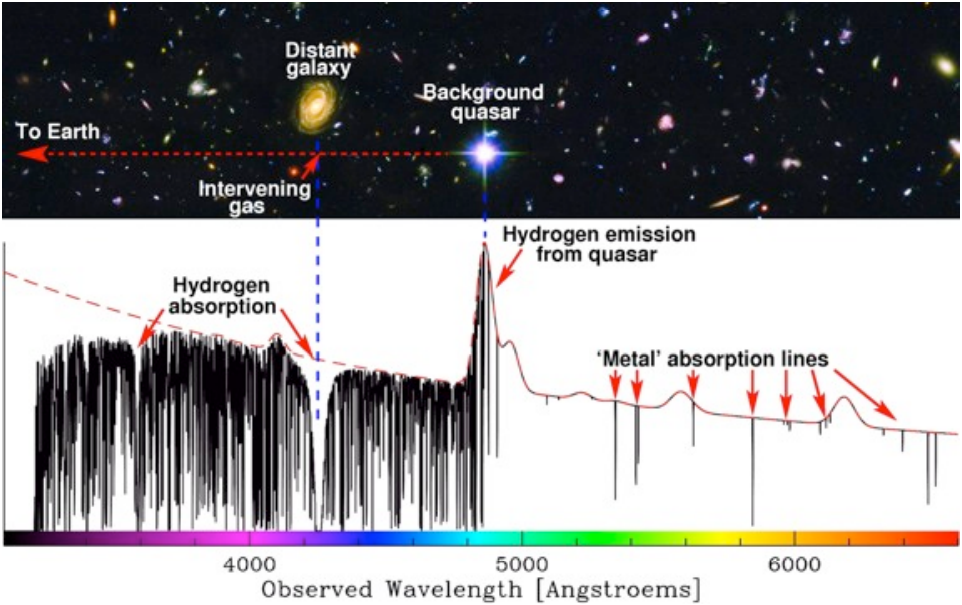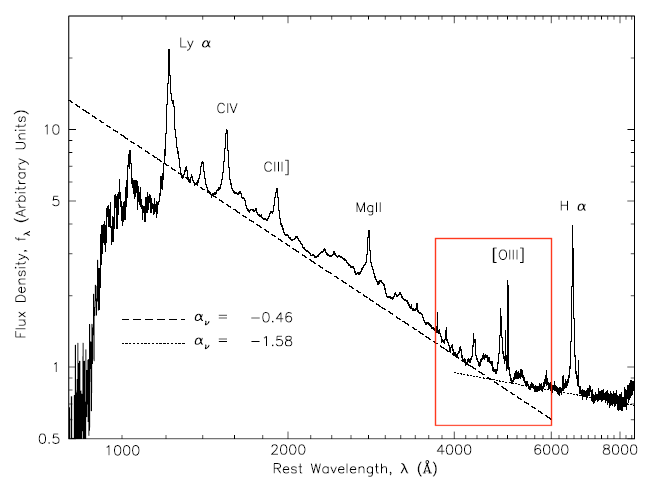【搬运】【wiki】QSO与AGN
【分布特征】
### 分布方向性
There are more quasars in one direction (towards Hydra) than in the opposite direction.
----<wiki | quasar | modern observations>20220703Sun
### 中心质量估计方法
Central masses of 10^5 to 10^9 solar masses have been measured in quasars by using reverberation mapping.
----<wiki | quasar | current understanding>20220703Sun
### SDSS DR16
More than 750,414 quasars have been found, most from the Sloan Digital Sky Survey.
----<wiki | quasar | properties>20220703Sun
ovo
ovo
ovo
【电磁特征】
### 10%射电噪
Not all quasars have strong radio emission, only about 10% are "radio-loud". Hence the name "QSO" is used to refer to these objects, further categorised into the "radio-loud" and the "radio-quiet" classes.
----<wiki | quasar | modern observations>20220703Sun
### QSO有所有其它活动星系的共同特征。QSO=AGN?
Quasars exhibit all the properties common to other active galaxies such as Seyfert galaxies.
### 最亮HI Lya发射线,少部分强射电发射。
Most quasars are brightest in their rest-frame ultraviolet wavelength of 121.6 nm Lyman-alpha emission line of hydrogen, but due to the tremendous redshifts of these sources, that peak luminosity has been observed as far to the red as 900.0 nm, in the near infrared. A minority of quasars show strong radio emission, which is generated by jets of matter moving close to the speed of light.
### QSO红移,紫外发射谱的元素最亮线
Quasar redshifts are measured from the strong spectral lines that dominate their visible and ultraviolet emission spectra. These lines are brighter than the continuous spectrum. They exhibit Doppler broadening corresponding to mean speed of several percent of the speed of light. Fast motions strongly indicate a large mass. Emission lines of hydrogen (mainly of the Lyman series and Balmer series), helium, carbon, magnesium, iron and oxygen are the brightest lines. The atoms emitting these lines range from neutral to highly ionized, leaving it highly charged. This wide range of ionization shows that the gas is highly irradiated by the quasar, not merely hot gas, and not by stars, which cannot produce such a wide range of ionization.


----<wiki | quasar | properties>20220703Sun
### 吸积盘O/UV波段,尘埃环X波段(逆康普顿散射)
The expected spectrum of an accretion disc peaks in the optical-ultraviolet waveband; in addition, a corona of hot material forms above the accretion disc and can inverse-Compton scatter photons up to X-ray energies. The radiation from the accretion disc excites cold atomic material close to the black hole and this in turn radiates at particular emission lines.
----<wiki | AGN | accretion disc>20220703Sun
### 喷流尺度太小,产生机制不明,可用VLBI观测亚角秒结构。喷流在全波段辐射,连续谱的第二个潜在源。
### 突然好奇为啥有两条射流,必有一条和角动量方向相反啊,这为什么能喷出去?
The jet production mechanism and indeed the jet composition on very small scales are not understood at present due to the resolution of astronomical instruments being too low. The jets have their most obvious observational effects in the radio waveband, where very-long-baseline interferometry can be used to study the synchrotron radiation they emit at resolutions of sub-parsec scales. However, they radiate in all wavebands from the radio through to the gamma-ray range via the synchrotron and the inverse-Compton scattering process, and so AGN jets are a second potential source of any observed continuum radiation.
----<wiki | AGN | relativistic jets>20220703Sun
ovo
ovo
ovo
【能量机制】
### 高光度来自于SMBH吸积盘,优于恒星核聚变p-p链
The huge luminosity of quasars results from the accretion discs of central supermassive black holes, which can convert between 6% and 32% of the mass of an object into energy, compared to just 0.7% for the p–p chain nuclear fusion process that dominates the energy production in Sun-like stars.
----<wiki | quasar | current understanding>20220703Sun
### 引力势能转变为辐射
The emission of large amounts of power from a small region requires a power source far more efficient than the nuclear fusion that powers stars. The conversion of gravitational potential energy to radiation by infalling to a black hole converts between 6% and 32% of the mass to energy, compared to 0.7% for the conversion of mass to energy in a star like our Sun.
### 非热辐射
Radiation from quasars is partially "nonthermal" (i.e., not due to black-body radiation), and approximately 10% are observed to also have jets and lobes.
### 可能的极端高能机制
Extremely high energies might be explained by several mechanisms (see Fermi acceleration and Centrifugal mechanism of acceleration).
----<wiki | quasar | properties>20220703Sun
### 吸积盘加热机制
In the standard model of AGN, cold material close to a black hole forms an accretion disc. Dissipative processes in the accretion disc transport matter inwards and angular momentum outwards, while causing the accretion disc to heat up.
----<wiki | AGN | accretion disc>20220703Sun
ovo
ovo
ovo
【星系演化与星系中心SMBH假设】
### 燃料(gas and dust)消耗
Thus it is now thought that all large galaxies have a black hole of this kind, but only a small fraction have sufficient matter in the right kind of orbit at their center to become active and power radiation in such a way as to be seen as quasars. This also explains why quasars were more common in the early universe, as this energy production ends when the supermassive black hole consumes all of the gas and dust near it. This means that it is possible that most galaxies, including the Milky Way, have gone through an active stage, appearing as a quasar or some other class of active galaxy that depended on the black-hole mass and the accretion rate, and are now quiescent because they lack a supply of matter to feed into their central black holes to generate radiation.
----<wiki | quasar | current understanding>20220703Sun
### AGN叫停恒星形成——反馈假说
These black holes co-evolve with the mass of stars in their host galaxy in a way not fully understood at present. One idea is that jets, radiation and winds created by the quasars shut down the formation of new stars in the host galaxy, a process called "feedback".
----<wiki | quasar | properties>20220703Sun
ovo
ovo
ovo
【早期宇宙】
### 谱线发射吸收与再电离
Quasars also provide some clues as to the end of the Big Bang's reionization. The oldest known quasars (z = 6)[ display a Gunn–Peterson trough and have absorption regions in front of them indicating that the intergalactic medium at that time was neutral gas. More recent quasars show no absorption region, but rather their spectra contain a spiky area known as the Lyman-alpha forest; this indicates that the intergalactic medium has undergone reionization into plasma, and that neutral gas exists only in small clouds.
### 星系形成时出现的再电离机制
The intense production of ionizing ultraviolet radiation is also significant, as it would provide a mechanism for reionization to occur as galaxies form. Despite this, current theories suggest that quasars were not the primary source of reionization; the primary causes of reionization were probably the earliest generations of stars, known as Population III stars (possibly 70%), and dwarf galaxies (very early small high-energy galaxies) (possibly 30%).
### 重元素痕迹,星族三假说(BB到第一个可观QSO之间)
Quasars show evidence of elements heavier than helium, indicating that galaxies underwent a massive phase of star formation, creating population III stars between the time of the Big Bang and the first observed quasars
----<wiki | quasar | the early universe>20220703Sun
ovo
ovo
ovo
【AGN分类】
###
分类主要是根据AGN形态(相对指向)来分的,而不是按照真实物理区别来分的。
1 射电静AGN,90%
1.1 Seyfert,有光学核连续发射和光学窄线发射,宿主星系形态通常是螺旋或不规则。Seyfert I有强光学宽发射线和光学连续谱,更大概率有强的低能X发射;Seyfert II没有此宽发射线;据此还有更多亚类。
Seyfert 1能直视AGN,Seyfert 2受尘埃环遮挡严重(难以直接观测宽线发射和软X发射)。
1.2 射电静QSO,光度比Seyfert I更亮,兼有强的光学、X连续发射和窄光学发射线。
2 射电噪AGN,10%
2.1 blazar/OVV quasar,强烈、瞬变(喷流,几年几月的水平)、极化的光学、射电和X发射,少有光学发射线(红移从宿主星系推断)。
2.2 射电噪QSO,像射电静QSO,但是多了喷流的发射。强光学连续谱、强光学宽窄发射线和强X发射,兼有核加延展的射电发射。
2.3 射电星系,主要有核加延展的射电发射,别的性质各异,没有核区的光学连续谱和X发射(只有与喷流相关的),宿主星系形态基本是椭圆。可再分为低激发(没有强的光学宽窄发射线)、高激发(窄发射线,与Seyfert II类似)和宽发射线(相对强的和光学连续发射)。


最简单的基于AGN统一模型的视角分类是不完整的,Seyfert1和2看起来在恒星形成和AGN功率上有所差别。
----<wiki | AGN | types of AGNs + unification of AGNs>20220703Sun




【推荐】国内首个AI IDE,深度理解中文开发场景,立即下载体验Trae
【推荐】编程新体验,更懂你的AI,立即体验豆包MarsCode编程助手
【推荐】抖音旗下AI助手豆包,你的智能百科全书,全免费不限次数
【推荐】轻量又高性能的 SSH 工具 IShell:AI 加持,快人一步